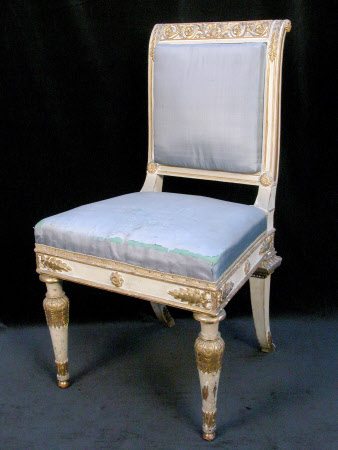Chair
probably Carlo Randoni (1755-1831)
Category
Furniture
Date
circa 1820 - 1827
Materials
Pine, walnut, paint, gilding and silk
Measurements
91.5 x 50.5 x 50 cm
Place of origin
Genoa
Order this imageCollection
Attingham Park, Shropshire
NT 608157.1.3
Summary
A chair, one of a set of fourteen pieces of seat furniture, of gilded, carved and painted pine and walnut, probably designed by Carlo Randoni (1755-1831), Genoa, for Palazzo Tursi, Genoa, circa 1820-7. The set comprising five chairs, two open armchairs and seven stools. Topped by a scroll-over toprail carved with buds, flowers and leaves, above a padded and covered back panel between uprights topped by gilt leafy 'capitals'. The seat in seat rails decorated to the centre with a single gilded rosette, and rosette and acanthus clasps at the corners. Raised to the front on a pair of turned and tapering legs with an upper gilt ring-turning, leaves and a fluted lower collar above gilt ball feet. The tapering rectangular-section outswept rear legs topped by fluted giltwood capitals and with hoof feet. Covered in 20th century pale blue silk.
Full description
This chair is part of a set which is, in turn, one of four sets of chairs, armchairs and stools of this type at Attingham (NT 608150, 608157, 608166 and 608168). The four sets are all in the Italian neoclassical style and identical in form, and are only distinguished by the use of different motifs to decorate the toprails, seat rails and legs, and by their coverings which are various and not consistent within sets. Following recent research by National Trust furniture curators, this furniture is now attributed to the architect and designer Carlo Randoni (1755-1831), not only because his influence is indicated by the fact that there are other pieces of furniture at Attingham for which his designs survive (NT 608155, NT 608156 and NT 608166), but also because many of the pieces of seat furniture have been signed or marked by craftsmen who are known to have worked for Randoni during the refurbishment of Palazzo Tursi in Genoa in the 1820s. Palazzo Tursi, the residence of King Vittorio Emanuele I (1759-1824) and Queen Maria Teresa (1773-1832), was converted into a royal palace in 1819-21 and was modified again in 1824-27. An inventory of May 1822 listed ten sofas, twelve armchairs, 136 stools, eighteen 'x'-frame stools and thirty-eight chairs amongst the contents of the Palazzo. Maria Teresa (by then the Queen Dowager following Vittorio Emanuele's death in 1824) died in 1832 and, although no evidence of a sale, or a dispersal auction, has been found, it is believed that William Noel-Hill, 3rd Baron Berwick (1773-1842), acquired this furniture when returning home to England via Genoa in 1833. Throughout his time in Italy as a diplomat, William Noel-Hill had lived in close proximity to the Sardinian court, initially in exile at Cagliari (1808-14) and then Turin (1814-24), and after his diplomatic move to Naples (1824-33) he retained a house in Genoa. In 1842, when an inventory was taken at Attingham his death, the bulk of the furniture was in storage in the Old Dining Room, but was subsequently used to furnish the house. Most of it remains in situ, and it is said to form probably 'the largest collection of its kind in the British Isles'. The stools, armchairs and chairs in this set are covered in four different fabrics. This chair was covered in pale blue silk in the 20th century. Four matching chairs are in the Palazzo Reale in Genoa, from 1823-31 the official residence of King Carlo Felice (1765-1831), Maria Teresa's brother-in-law. Another eight chairs and a pair of canapés from this set were sold at Christie's in November 2019, and several bore craftsmen's names or marks, including Laviosa (gilder) and Parodi (carver and gilder), both of whom also signed some of the pieces at Attingham.
Provenance
3rd Lord Berwick collection: William Noel-Hill, 3rd Baron Berwick (1773-1842). Acquired by the 3rd Lord Berwick, who had been in Italy as British envoy and ambassador to the Kingdom of Naples and the Two Sicilies. By descent bequeathed to the National Trust with the estate, house and contents of Attingham by Thomas Henry Noel-Hill, 8th Baron Berwick (1877-1947) on 15th May 1953.
Marks and inscriptions
Front seat frame rail: Disculto[?] Rear seat frame rail: 39[?] Front leg blocks: 12
Makers and roles
probably Carlo Randoni (1755-1831), designer
References
Rowell & Burchard 2020: Christopher Rowell & Wolf Burchard, 'Italian Furniture at Attingham Park', Furniture History LVI (2020), 107-176, pp. 147-9, 152-3, 173 fn. 179, 182 Figures 46 & 47 Drury, 1984: Martin Drury. “Italian furniture in National Trust houses.” Furniture History, vol. XX, 1984., pp. 38-44
